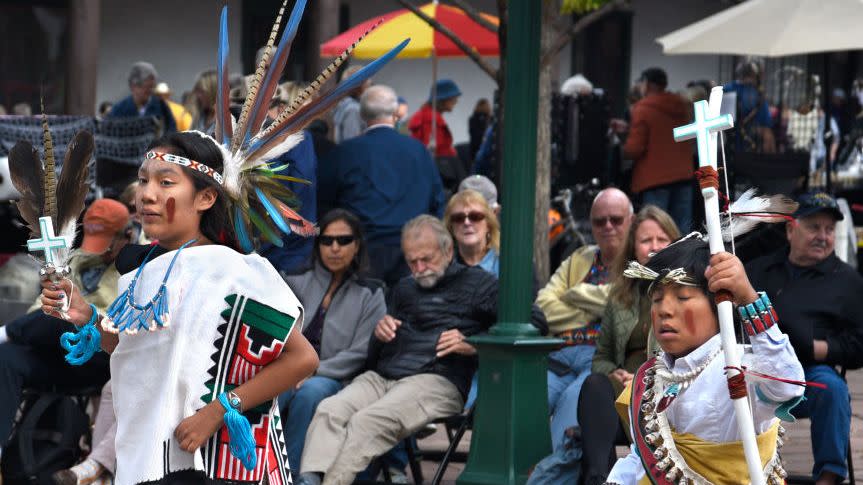Why Some States Celebrate Indigenous Peoples' Day Instead of Columbus Day

- Oops!Something went wrong.Please try again later.
When Christopher Columbus sailed the ocean blue in 1492, he did not "discover" a wild, untamed land that was just waiting for the white man to stake his claim. Instead, he and the colonists that followed, displaced and decimated generations of Native American people who had rich cultures and societies of their own.
But that's not the history many of us learn in school, although many are working to remedy that. One of those changes includes recognizing Indigenous Peoples’ Day on the second Monday in October instead of Columbus Day. The idea first arose in 1977, and has gathered steam in recent years as many states and municipalities make the switch.
Columbus Day became a national holiday in 1972.
What many people also don't realize is that Columbus Day recognizes a cultural heritage beyond the man himself. Smithsonian Magazine reports that the first documented observance of Columbus Day took place in New York City in 1792, on the 300th anniversary of Columbus’s arrival. In 1869, the holiday became an annual celebration of Italian-American heritage in San Francisco, in part to recognize then-marginalized Catholic Italian-Americans. It only became a national observance in 1934, at the request of the Knights of Columbus and representatives from New York City’s Italian community. October 12 became a national holiday three years later, with a proclamation by President Richard Nixon declaring the second Monday in October a national holiday in 1972.
Italian-Americans are no longer marginalized, but Native people continue to be all but invisible in our history books and broader American cultural discourse. Currently, there are over 600 Native Nations in the United States, and 6.8 million Americans identify as Native American. That’s about 2% of the country’s total population.
Native Americans have protested it for generations.
While many non-Native Americans don’t fully realize the devastation Columbus wrought with his arrival, it’s not news to generations of Native people. As Leo Killsback, a professor of American Indian Studies at Arizona State University told History.com, “Columbus Day is not just a holiday, it represents the violent history of colonization in the Western hemisphere.”
Just a few years after the holiday’s official designation, Native Americans proposed a replacement. Participants at the 1977 United Nations International Conference on Discrimination against Indigenous Populations in the Americas proposed that Indigenous Peoples’ Day replace Columbus Day. They proposed that the holiday acknowledge that Native people are the first inhabitants of the Americas, and encourage Americans to rethink the history we’ve taken for granted since grade school.
Many states made the switch.
South Dakota became the first state to rename Columbus Day in 1990. Berkeley, Calif., became the first city to make the change in 1992. And in 2015, an estimated 6,000 Native people and their supporters gathered at Randall’s Island, N.Y., to recognize the survival of the Indigenous peoples of the Western Hemisphere. In 2019, Washington, D.C. passed a resolution to change the holiday to Indigenous Peoples’ Day.
“This change allows the opportunity to bring more awareness to the unique, rich history of this land that is inextricably tied to the first peoples of this country and predates the voyage of Christopher Columbus,” the National Congress of American Indians said in a statement. “It also acknowledges American Indians and Alaska Natives as thriving, contemporary sovereign nations who hold their rightful place among the American family of governments.”
The following states and the District of Columbia now observe Native American or Indigenous Peoples’ Day, in place of or in addition to Columbus Day:
Alabama
Alaska
California
District of Columbia
Hawai’i
Idaho
Iowa
Louisiana
Maine
Michigan
Minnesota
New Mexico
Nebraska
North Carolina
Oklahoma
Oregon
South Dakota
Texas
Vermont
Virginia
Wisconsin
Many cities, municipalities, universities and educational institutions also now recognize Indigenous Peoples’ Day or a similar holiday that recognizes the culture and history of Native peoples.
More change is needed in schools.
Of course, changing the name of a single day doesn’t nearly address the knowledge gap about Native history that still persists today. In 2015, Dr. Sarah Shear, with Ryan T. Knowles, Gregory J. Soden, and Antonio J. Castro published data showing that 87% of the references to Native Americans in U.S. curricula appear within the context of American history before 1900. “The narrative presented in U.S. history standards,” the report reads, “when analyzed with a critical eye, directed students to see Indigenous Peoples as a long since forgotten episode in the country’s development.” They also reported that history lessons, as a whole, “tell a traditional, Euro-American narrative of immigration in the United States that largely ignores historical and current acts of xenophobia and discrimination across the country.”
Some educators are working to change that. One such initiative is Native Knowledge 360, or NK360° a project of the Smithsonian National Museum of the American Indian. NK360° provides educational materials and teacher training that incorporate Native narratives, more comprehensive histories and information to create a more accurate, equitable curriculum. The program not only challenges our long-held historical misconceptions, but introduces students to the rich cultures of Native people today.
The program also includes teacher training, online materials and partnerships with advocacy groups to help change the conversation around Native communities and history. As NMAI puts it, “these efforts will result in a better-educated American public — one with an increased understanding of the complexity, diversity, and relevancy of Native peoples. Most important, Native youth themselves will no longer have to question why their stories are absent from their education.”
You Might Also Like

